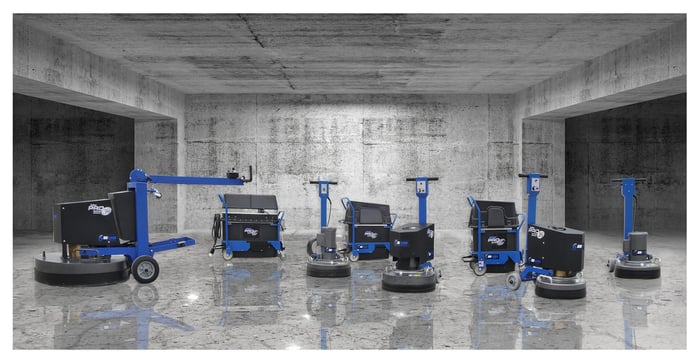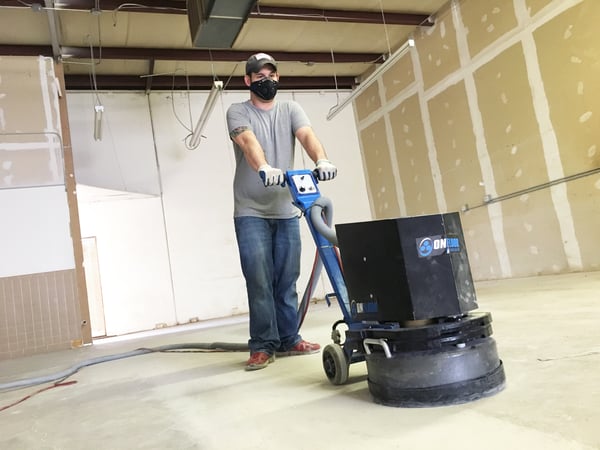Concrete floors are having a moment. Emerging as a versatile and durable flooring option, they are increasingly being chosen for both industrial and residential projects. But what transforms an ordinary concrete surface into a stunning and long-lasting floor?
The answer is simple yet powerful—grind and seal.
What is Concrete Grinding and Sealing?
Concrete grinding and sealing is a process that enhances the durability and aesthetic appeal of concrete surfaces. By grinding and sealing, contractors can create surfaces that are not only visually appealing but also withstand wear and tear.
Unlike concrete polishing, which involves a more labor-intensive process to achieve a high-gloss finish, grind and seal offers a cost-effective alternative with similar aesthetic benefits. This process has gained significant traction in the construction industry for its ability to produce high-quality, polished floors without the hefty price tag of traditional polished concrete.
The essence of grind and seal is in its dual benefits—it refines the surface for enhanced appearance while ensuring protection and longevity. This makes it an attractive solution for a wide array of applications, from warehouses and retail spaces to stylish urban lofts. In this post, we will explore the intricate details of this method and how it can redefine your flooring projects.
The Process of Concrete Grinding and Sealing
Concrete grinding and sealing involve several critical steps, each contributing to the final finish. Below we'll discuss the major steps involved in this process:
Step 1: Surface Preparation
The initial step involves cleaning the surface thoroughly to remove dust, dirt, and any existing coatings. This ensures that the grinder can effectively work on a clean surface, free of debris that could hinder the process. Once cleaned, the surface is inspected for any repairs that might be needed.
.jpg?width=600&height=450&name=IMG_0716%20(1).jpg)
Step 2: Grinding
Grinding is where the magic begins. Using engineered floor grinders fitted with industrial diamond abrasives, contractors grind the surface to achieve the desired level of smoothness and reflectivity. Machines like the Onfloor OF20S-H Multi-Surface Planetary Grinder are perfect for this task, offering high-speed performance and the ability to tackle everything from minor imperfections and polishing to more significant leveling tasks.
Step 3: Sealing
After achieving the desired texture, the surface is sealed to protect against stains, moisture, and wear. The choice of sealer will depend on the specific needs of the space, whether you’re aiming for a matte, satin, or glossy finish. Sealers enhance the color of the concrete and provide a protective layer that extends the floor’s lifespan. Additionally, sealed concrete floors require minimal maintenance due to their durability and scratch resistance, making them ideal for high-traffic areas.
Advantages and Applications of Concrete Grinding and Sealing
The benefits of grinding and sealing concrete go beyond aesthetics. This process offers a host of advantages that make it suitable for various industries and applications.
Durability and Maintenance
One of the most significant benefits is the increased durability of the floors. Sealed concrete is resistant to foot traffic, spills, and abrasions, making it ideal for high-traffic areas like retail stores and warehouses. Maintenance is a breeze, requiring only regular cleaning to keep it looking its best.
Versatility
Grind and seal can be applied to new or existing concrete slab surfaces, offering flexibility in its application. It suits a wide range of environments, from industrial factories to chic cafes. This versatility is a major draw for contractors looking to offer diverse flooring solutions to their clients.
Cost-Effectiveness
Compared to polished concrete, grind and seal is more affordable without sacrificing quality. It delivers a high-end look at a fraction of the cost, making it an attractive choice for budget-conscious projects while still maintaining a high standard of quality.
Unlike polished concrete, which varies based on the concrete's profile, grind and seal offer a more consistent appearance due to its reliance on a topical sealer. Additionally, the processes involve different costs and installation times, making grind and seal a preferred option for business owners seeking uniformity across their spaces.
In practice, these advantages have been demonstrated time and again. For instance, consider a bustling retail store where aesthetic appeal and durability are paramount. A grind and seal finish not only enhances the visual impact but also withstands the heavy foot traffic, ensuring the store remains inviting and operational.
Environmental Benefits of Concrete Grinding and Sealing
Aside from its aesthetic and practical advantages, concrete grinding and sealing also offer several environmental benefits.
Reduces Waste
Grinding and sealing uses existing concrete as the base material, reducing the need for new materials. This results in less waste being produced during construction or renovation projects, making it a more sustainable option.
Improves Indoor Air Quality
As mentioned earlier, concrete grinding can create a significant amount of dust. However, using a dust extractor system not only helps with cleanliness but also improves indoor air quality by capturing harmful particles before they disperse into the surrounding environment.
Minimizes Chemical Usage
Unlike other flooring options that require the use of harsh chemicals for cleaning and maintenance, sealed concrete floors can be easily cleaned with just water and mild soap. This reduces the need for chemical usage, making it a more environmentally friendly choice.
Long-lasting Solution
Sealed concrete floors have a longer lifespan compared to other flooring options, reducing the need for frequent replacement and thereby minimizing waste production. Additionally, the durability of sealed concrete means less energy and resources are needed for repairs or replacements.
When comparing sealed and polished concrete, sealed concrete generally offers a longer lifespan due to its protective layer, while polished concrete, though highly durable, may require more maintenance over time.

Common Mistakes to Avoid
While the grind and seal method is relatively straightforward, there are a few common mistakes that contractors should avoid to ensure a flawless finish.
Insufficient Surface Preparation
Adequate surface preparation is critical for the success of this process. Failure to properly clean and repair the surface can result in an uneven or weak bond between the sealer and the concrete. This can lead to premature wear and tear, compromising the longevity of the floor.
Using Wrong Equipment
Using inadequate or improper equipment can also lead to unsatisfactory results. It’s essential to choose high-quality grinders and sealers specifically designed for concrete surfaces, as part of a polished concrete system, like those by Onfloor Technologies.
Inconsistent Sealing
The application of sealer should be consistent and uniform to achieve a smooth, flawless finish. Irregular sealing can result in an uneven appearance and may even lead to discoloration over time.
Expert Tips for Success
To ensure a successful grind and seal process, here are some tips from industry experts:

Invest in High-Quality Equipment
To truly achieve the desired result and reap the full benefits of concrete grinding and sealing, it's crucial to invest in top-quality equipment. This will not only save time and effort but also ensure a professional finish that meets or exceeds client expectations.
Prioritize Surface Preparation
As mentioned earlier, proper surface preparation is key to a successful grind and seal project. Be sure to thoroughly clean and repair any existing imperfections before proceeding with the grinding and sealing process.
Experiment with Different Sealers
Different types of sealers offer unique finishes, so don't be afraid to experiment with different options to find the best fit for your project. Matte, satin, and glossy finishes can all add a touch of character and personality to a space, so be sure to offer your clients a variety of choices.
Use a Dust Extractor System
Concrete grinding can create a significant amount of dust, which can be hazardous to health and cause damage to surrounding areas. To minimize this, it's important to use a dust extractor system during the grinding process.
Test Different Sealers
Before sealing the entire surface, it's recommended to test different sealers on a small area. This will help ensure that the chosen sealer performs as expected and achieves the desired look.
Regularly Maintain Sealed Concrete Floors
Finally, remember that proper maintenance is crucial for the longevity and appearance of sealed concrete floors. Regular cleaning and occasional resealing will help keep them looking their best for years to come.

FAQs
Q: Can grind and seal be applied to both interior and exterior surfaces?
A: Yes, grind and seal can be used on both interior and exterior concrete surfaces. However, it's important to choose the right sealer for the specific conditions of each space.
Q: How long does a grind and seal process typically take?
A: The duration of a grind and seal project will depend on various factors such as the size of the surface, the condition of the existing concrete, and the type of sealer used. On average, it can take anywhere from one day to several days to complete.
Q: Is a grind and seal finish durable enough for heavy industrial spaces?
A: Absolutely. The durability of a grind and seal finish makes it suitable for even the most demanding industrial environments.
Q: Can grind and seal be applied to colored or stained concrete?
A: Yes, grind and seal can be applied to both plain and colored/stained concrete surfaces. However, it's important to choose a sealer that complements the existing color without altering it.
Q: What is the difference between polished concrete and grind and seal?
A: A polished concrete floor uses progressively finer grits of diamond abrasives to create a shiny, smooth surface. Polished concrete floors, on the other hand, use a similar grinding process but finish with a sealer instead of a polishing compound. This results in a glossy or matte finish, depending on the type of sealer used.
So while both processes involve grinding concrete, polished concrete has an additional step of polishing that creates a higher sheen and smoother surface compared to grind and seal.
Conclusion
Concrete grinding and sealing is a versatile and cost-effective method for achieving beautiful, durable floors in a variety of settings. With the right equipment, preparation, and expert tips, contractors can produce stunning results that meet or exceed client expectations.
Whether it's for commercial or residential use, the grind and seal process offers numerous benefits that make it a valuable tool in the flooring industry.
5 comments